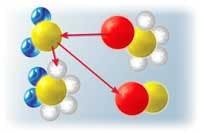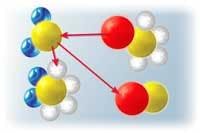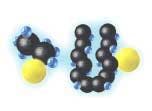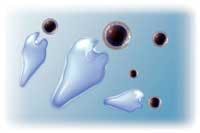The motivating forces behind most treatment and disposal of biosolids for any environmental management process are regulatory compliance and cost reduction. Neither of these apply to biosolids odors, which are unregulated. However, public acceptance of "land application" — the disposal method favored by current Part 503 regulations — hinges in large part on adequate odor control. Additionally, odor issues will continue to have a strong influence on both in-plant and off-site practices relative to biosolids.
Odor in biosolids results from the same bacteria that exist in, and are responsible for odor in nearly all stages of the wastewater treatment process. These bacteria have a preference for dissolved oxygen for respiration. However, dissolved oxygen is usually present in biosolids for only a brief time after mechanical mixing, agitation, or handling. When the dissolved oxygen is expended, these bacteria will turn — in order of preference — to the oxygen contained in nitrates and sulfates. Since there is generally very little nitrate present to meet this demand for sources of oxygen the bacteria will begin to consume sulfate.
The by-products of sulfate respiration are sulfides and reduced sulfur compounds such as mercaptans. Sulfide is the leading cause of the odor and corrosion problems associated with biosolids, which occurs when the sulfides are mixed with air and form hydrogen sulfide.
Odor Prevention
To prevent odor causing compounds from being formed in sludge and biosolids, a stable level of nitrates has to be maintained to satisfy the oxygen demands of the sulfur reducing organisms present. The nitrate is consumed in preference to sulfates and its use in respiration by these bacteria results only in the production of odorless and harmless nitrogen gas. The Bioxide® Odor Control Process from USFilter provides the levels of nitrate for odor control and is used in many biosolids applications.
Odor Removal
When nitrate coexists with pre-formed reduced sulfur compounds, sulfide, the Bioxide process encourages a unique class of denitrifying bacteria in the biosolids. This group of bacteria consumes existing sulfide in the presence of nitrate and are known as lithotrophic, literally meaning, "rock eaters". They will "eat" sulfide for energy using nitrate as the "fuel" for the process and thus remove existing odor causing compounds.
Bioxide solution can be added during many phases of the biosolids thickening process. Where it is added depends on where the odor control treatment is desired. For transport and final storage, the solution is normally sprayed upon the thickened biosolids and mechanically mixed in during the transport of the material to the trucks or storage areas. Treatment can begin earlier in the process to begin odor control in buildings or rooms where the biosolids are handled.
If desired, the nitrate solution can be added to sludge holding tanks to start controlling odors in the tank and in thickening equipment such as presses and centrifuges. Treatment should continue through the transport loading process and all the way to the biosolids' final destination for comprehensive odor control.
The odor control process controls odors caused by reduced sulfur compounds such as hydrogen sulfide and mercaptans by preventing their formation and removing them prior to treatment. The process uses no harmful or environmentally hazardous materials and produces no undesirable by-products. It is an aqueous solution of non-hazardous nitrate salt, as defined by the EPA CERCLA list. Therefore, the use of Bioxide solution does not expose workers or the public to potentially dangerous situations.
Longer-Term Odor Control
Longer-term odor control can be achieved with the use of a proprietary, patented process that literally blocks the respiration of sulfate.
This process — available commercially as Bioxide-AQ™ — acts as a "filler" in the cytochrome-C3 pathway that sulfur-reducing bacteria use to access sulfate. When Bioxide-AQ — with its special formulation of anthraquinone, known as AQuit™ — is present, odor causing bacteria effectively "skip" the sulfate respiration process where most of the odor causing compounds are formed.
Atmospheric H2S Control
Iron salts — available commercially in products such as Odophos® and Odofree™ — can be an economical odor and corrosion solution if only dissolved sulfide and atmospheric hydrogen sulfide control is desired. Iron salts provide a reducing ion of iron (Fe2+) that interacts preferentially with dissolved sulfide that is formed during sulfate respiration by the bacteria in the biosolids. With the dissolved sulfide bound up as ferrous sulfide, very little atmospheric odor and corrosion causing hydrogen sulfide is released during interaction of the biosolids and air. Iron salts can be added prior to most thickening processes, and also after the dewatering if very good mixing of the iron salts and thickened biosolids is available.
Conclusion
The effectiveness of nitrate and anthraquinones has been well documented in independent laboratory tests using both human detection panels and Gastec Detector Tubes. Definitive test data can be found in a joint paper authored by USFilter, DCWASA, and USDA (see References and Suggested Reading). Test data has also shown that the combined use of nitrate and anthraquinones creates a synergistic effect that leads to a higher degree of bacterial inhibition than the use of either nitrate or anthraquinones alone.
References and Suggested Reading:
Abu-Orf, M.; Peot, C.; Rameriz, M.; Laquidara, M.; McConnell, L.; Kim, H.; Hunniford, D. (2002). Inhibiting the Production of Odors from Dewatered Residuals Using Nitrates and Anthraquinones. Published by USFilter.
Ballinger, K., Burger, E.; Knauer, R. (2001). Method for reducing hydrogen sulfide level in water containing sulfate-reducing bacteria and hydrogen sulfide-metabolizing bacteria. US Patent #6,309,597.
Kim, H.; Nochetto, C; McConnell, L. (2001). "Gas Phase Analysis of Trimethylamine, Propionic and Butyric Acid, and Sulfur Compounds Using Solid Phase Microextraction." Analytical Chemistry (accepted).
Hunniford, D. and Davis H. (2001). Process for removal of dissolved hydrogen sulfide and reduction of sewage BOD in sewer or other waste systems. US Patent #RE37,181.
Wimer et al., (1995). Anthraquinones as inhibitors of sulfide production from sulfate reducing bacteria. US Patent #5,385,842.







